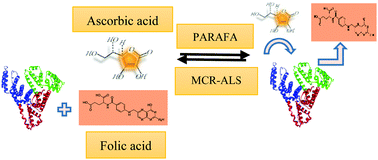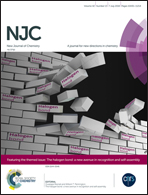Novel insights into the effect of folate–albumin binding on the transport of ascorbic acid as an anticancer agent: chemometric analysis based on combined spectroscopic and electrochemical studies†
Abstract
One type of cancer treatment is based on the generation of reactive oxygen species (ROS). Ascorbic acid is an effective nutrient and is commonly regarded as an antioxidant, but it can act as a pro-oxidant at pharmacological concentrations. It can generate the ascorbate radical and hydrogen peroxide, which induce cytotoxicity toward different types of cancer cells in vitro. Although a variety of cancer cells can be killed by ROS, the development of pro-oxidant drugs has been limited by their toxicity to healthy cells. Tumor targeting with folic acid for the selective targeting of folate receptor has been proposed as a promising strategy for cancer therapy and the delivery of therapeutic agents such as ascorbic acid into tumor cells. Recently, it was reported that the modification of folic acid conjugates with an albumin binding entity influences the function and bioavailability of drugs. Thus, the goal of this study is to evaluate the electrochemical behavior of a mixture of ascorbic acid and folic acid upon interaction with albumin based on electrochemical techniques. Furthermore, the latter techniques and ultraviolet and visible (UV-vis) spectrophotometry can reflect the redox activity of the complex species, and their electrochemical mechanisms and biochemical behaviors in the generation of ROS. Also, this study reveals the molecular details of the binding and thermodynamic parameters and a novel and unexpected drug-binding site in the presence of other components using chemometric models and docking studies.



 Please wait while we load your content...
Please wait while we load your content...